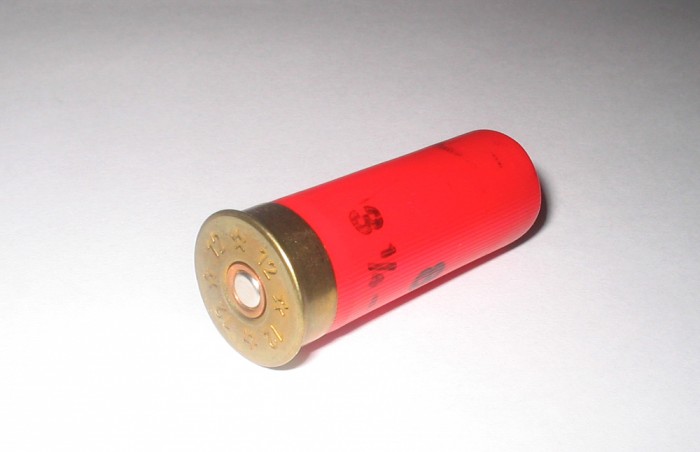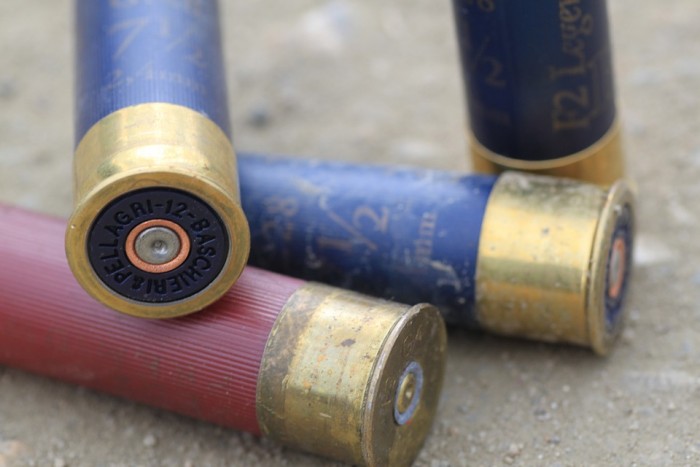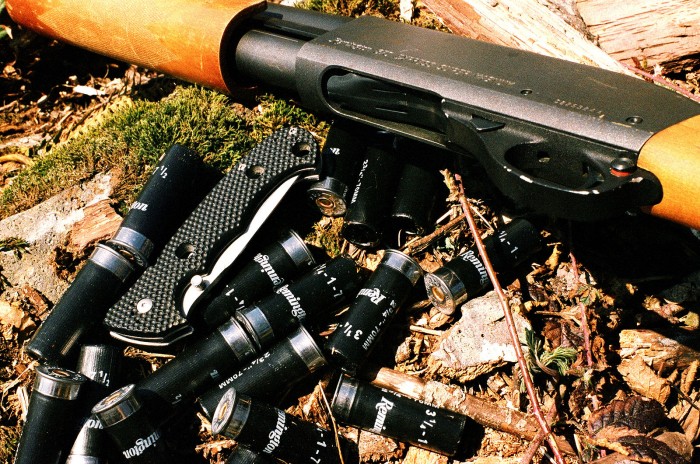
Shotgun shooting has been a much loved pass time throughout the country for centuries and has developed from a couple of country gents clearing their land into a competitive and regulated sport. Game hunting with shotguns used to be so popular in fact that a 1548 Act of parliament banned “shoting of hayle-shot wherby an infinite sort of fowle is killed and much gaym therby distroyed”. The weapons used in these hunts were often ex military and wildly unpredictable until the invention of the flint lock in the 16th century.
Back then there wasn’t much choice for ammunition as black powder and lead, sometimes stripped from stained-glass windows amongst other things, were loaded directly into the barrel. Nowadays there are many types of shotgun cartridges are available all throughout all of the UK and the various different sports and activities require this different ammunition for their shooters to be effective. A clay is going to need different ammunition from a live goose to be effective for example.

A Shell by its Cover
First of all let’s talk about how a shotgun cartridge works. From the outside there appears to be 2 different components to the cartridge, a plastic outer case and a brass head that ends in a thicker rim. The casing is available in various colours which only makes a difference when retrieving cartridges and you are slightly colour blind like me, then cartridges which I am assured are bright red seem to blend in very well with the mud and soil beneath them. Other than that they have no real relevance except some manufactures make certain gauges different colours, for example 20 gauge is often yellow, to prevent accidental misloading, again not much use if you are colorblind but at least I can appreciate the effort.
There is also the brass which is not actually made from brass and is instead electroplated steel. This is why cartridges can rust when not stored correctly. The brass is available in different lengths which is extremely important when you consider that the brass does… almost nothing. Aside from making your cartridges more expensive that is and I guess they look pretty. But modern shells have no real need for a brass, the theory goes that once upon a time brass was required because the powder used in shells burned much hotter than it did today and so, the higher the brass, the more powder used. Today the advantages of “high brass” shells are marketing gimmicks designed to trick new shooters into buying their products, old wives tales and excuses for when a called clay flies past without being shot. Take your pick, I’ve heard them all.
Gauging Interest
Gauge is an old English Imperial measurement that relates the amount of lead that can be rolled down a shotguns barrel to make a set weight, it all seems pretty over complicated so just remember, the lower the number, the bigger the shell. The exception to this is the .410 gauge which is an American invention based on the .45 colt round, Americans just love to be different don’t they? The size of shell does not always equate to power, as shot size and types of power have a part to play, but a larger shell can fit more shot and gunpowder inside it so it is a good rule of thumb to go by.
There are various gauges that are used for shotgun shells which obviously match the calibre of the shotgun you are using. There are 3 often used sizes and by far the most popular of these 3 is 12 gauge, a great all round size that can be used for both clay pigeons and game and provide great versatility at both. Put simply, there is a reason why it is the most popular cartridge. 20 gauge is the next size down from this and is designed to be a similar power level to the 12 gauge but with less recoil. The .410 is the next size down still and only really suitable for the smallest of targets. There are also other rarely used gauges such as 10, 16 and 28 but the majority of cartridges you encounter will likely be one of 12, 20 and .410 gauges.
Generally I would say use the largest gauge that your shoulder can take. The higher the gauge the more pellets in the shell and the the higher chance of hitting your target but also the higher the recoil rate and the more fatigue you will experience, throwing off your aim after a while. 12 gauge is the ideal choice as there is far more variety in shells out there for a 12 gauge although manufacturers of the 20 gauge are slowly catching up. This point seems incidental but I’ve never seen any 16 gauge shells on the shelf in any gunshop I’ve ever been to so if you’re after a quick point and shoot, a more common gauge might be the way to go.
Its what’s Inside that Counts
The inside of the cartridge houses a variety of different ingredients that work together to produce an effective shotgun spread. Starting at the back, there is the primer. The primer is a small piece of metal in the centre of the rim that creates a spark when hit by the hammer of the shotgun. All primers a pretty much the same and do not effect the overall performance of the cartridge.
The primer ignites the gunpowder which is available in a variety of different formulations that burn a different rates. The basic rule of thumb is, that faster the powder burns, the faster the shot is pushed out the barrel. This means that less lead, how far in front of the bird you have to shoot, is required making it easier to hit a fast moving object. Slower burning powders do have an advantage as well however, they often burn more evenly resulting in tighter spreads. You will also feel far less recoil with slower burning powders. Basically, the slower burning powders push the shot out of the barrel more evenly
My personal preference is to choose something mid range siding on the slower side. Just 6m past the end of the barrel, even the fastest loads are travelling at sub sonic speeds and the bigger the shot size, the faster this slowing effect takes place. Basically the speed of the shot makes little difference to the overall performance of the cartridge except the lead required, that’s lead as in distance and not the metal, and shooters who have been at it a long time can counteract this effectively.
Next up is the wad. This little piece of material is what pushes the shot out of the barrel and is primarily to prevent the powder and shot from mixing and to provides a solid base which prevents gas from passing through that shot as opposed to propelling it forwards. This wadding is available in either plastic or fibre. I almost always choose fibre. The reason for this is very simple, plastic is actually slightly the better wad offering better stability and producing better spreads at distance, but the majority of shooting places do not allow it for the simple reason that it is not bio degradable. I only know of one range near me that allows plastic wadding whilst all the rest require that you use fibre so make sure you know where you are headed before you buy.
Shots at the Bar
The last and most important part of choosing shotgun cartridge is the shot. The shot is the balls of metal, usually lead, that is inside the cartridge and are then fired out of the barrel. Although the majority of shot is lead, steel shot is required when shooting water fowl this is to prevent lead from entering any local water supply where its toxicity can be very hazardous to the environment. In steel you will more than likely as need a larger shot size than normal as steel is a harder metal than lead and has a tendency to pass right through the animal without transferring its energy if a smaller shot size is selected.
Also, just to be difficult, steel shot is sized in a different way than lead so bear that in mind when selecting. Be aware your shotgun will need to be proofed for steel shot as the harder metal can damage the inside of the barrel. Almost all modern guns come with this proofing as standard and most older guns can be proofed for a reasonable price.
Cartridge Shot Size
Shot size is probably the most important decision you are going to make and entirely dependant on what you are going to be shooting (see diagram). Smaller sizes, 9 to 7, are more suited to clays and sizes range all the way up to SG or LG, around 9.1mm across, but unless the zombie apocalypse actually happens, it is unlikely you are going to need any shot larger than AAA or BB for even the biggest of targets.
These are really a guideline as we shooters are a suspicious bunch and tend to stick with what works well for us personally. Any shop that tells you the size 7 shot is significantly better than 7.5 because of its greater mass is just trying to shift some old stock. Try what feels good for you, just bear in mind that when shooting live birds, no one likes wounding animals so it is better to go for bigger shot than usual as the higher mass transfers for energy into the target for more one shot kills.
When shooting clays, I generally find smaller shot to be more effective simply because of the fact that smaller shot fit more pellets into a cartridge, for example 210 size 9 pellets fit into a 12 gauge shell compared to just 120 size 7 pellets despite the size difference being just 0.4 mm. It matters less if the clay is “winged” so generally I go for the smallest shot I can get way with for more pellets in the spread and better chance of scoring.
My Recommendations
For Clay Shooting
For clay shooting, you cant get much better than Size 9 Comp X from Hull Cartridge. Voted clay cartridge of the year in 2012, these are fantastic shells with a small shot size for a greater number of pellets hitting your target and tight groupings coming from the slower burning powder. The plastic wadding also enhances accuracy but is not suitable for all ranges.
If you are willing to spend a little more money, the Sovereign Fibre 28g 8 Shot feature a slightly larger shot size that has been hardened for competition use. This hardening process reduces the deformation of the lead pellets under the extreme acceleration that occurs when the cartridge is fired. This greatly causes much tighter spreads and makes this ammunition the ideal choice for seasoned shooters. The Sovereigns also feature a fibre wad meaning they can be used on any range throughout the country and a re my personal go to when it comes to clay pigeon shooting..
For smaller guns, I would certainly recommend these .410 Gauge Game & Clay cartridges which are some of the best .410 shells I have ever shot. They aren’t going to be taking down albatross but they are suited to game and clay shooting and make ideal practice round thanks to their low recoil.
In the 20 gauge range there are the Subsonic 23g make great clay cartridges thanks to their low recoil, trust me your shoulders will thank me. These are also suitable for younger shooters as their lower recoil is not only less fatiguing but also more forgiving with your aim. They produce reliable spreads for a slower round and provide a large “kill zone” for maximum effectiveness.
Cartridges For Hunting Game Birds
The High Pheasant Fibre 30g 6 Shot is perfect for, as the name suggests, pheasant but also other similar sized birds. 6 shot is the ideal size for a combination of both power and accuracy resulting in less wounded birds and more food on the table. The Imperial Game 28g 6 Shot are of similar size and weight but feature significantly faster velocities if you are shooting particularly manoeuvrable birds. Their wider spread makes the ideal for beginners all the way through to seasoned veterans and should help you dramatically increase your shot/kill ratio.
In 20 gauge some of the best shells I have ever used are the Remington Premier Cartridges which are great all rounders and are superbly suited for shooting disciplines of almost any kind. Remington is a well respected brand name and these shells live up to the promise of quality. They are superbly smooth to cycle and shoot with minimal recoil, saving your shoulder for many shoots

to come.
For larger birds I would personally recommend the Extreme Hunting 50g BB Shot there is not much on the market that is more powerful than these particular shells. Filled with shot that is around 4.1mm across and with velocities in the region of 1375 fps, hit something with one of these and it stays dead. These shells possess the power to take down even the largest of targets and with their larger shot size ensure all of this energy is transferred into the target for maximum damage and a quick, humane death. It is a good job that these kill with one hit as your shoulder is not going to thank you for being inefficient. It takes a lot of force to move pellets of this size so pack a thick shooting jacket.
Hunting Water Fowl
Where steel shot is required, these Solway Steel Magnum shells are ideal for mallard and other ducks and their larger shot size should prevent the pellets from passing straight through the bird. For smaller water birds, the Steel Game 32g, are going to be ideal and are very reasonably priced, especially when you consider that steel shot can outstrip the price of lead shot, sometimes several times over.
These Pro Steel shells are another cheaper alternative steel cartridge although be aware they do contain plastic wadding and are not suitable for everywhere. They are high velocity shells that decrease lead times making them ideal for faster moving targets and are a great all round shell for someone looking to do a bit of everything.
D.I.Y Your Own Shells?
It is also possible to reload your own shells. Since the price hike in lead a few years back, reloading your own ammunition has never been more popular. Savings of up 60% compared to buying pre made cartridges are nothing to be sniffed at and with todays, modern reloading presses, a surprisingly high level of quality can be achieved. To be able to do this you will first need an explosives license to buy the gunpowder required. Theses are simple enough to obtain for those who already own a shotgun certificate and no extra authorisation is needed for nitro propellants.
Once you have got your license, you are ready to go to work. There are various tools required but favourites of mine are the de- and re-capper which allow old shells to be re-used so you can do do your bit for the environment before you blow it apart.
We stock a variety of powders that range in how hot they burn from Korma all the way up to Vindaloo and produce various pressures for shot of all sizes and metals. Sticking with the food analogy, they say there is nothing tastier than food you have made yourself and there is certain level of satisfaction that comes from taking down a pheasant with your own shells. If you can afford all the shooting equipment to get started then it is something I highly recommend, that equipment will pay for itself with in the year, depending on how often you shoot, so think of that initial outlay on the equipment as an investment in your continued shooting success.
To Sum Up
One final note, shotgun shells are made from a variety of different components that can be effected by environmental conditions such as temperature and moisture so always store them in dry conditions and at room temperature. IE on the floor in the garage is not the best idea, for a variety of reasons.
Perhaps only secondary to choosing your shotgun, the choice of your shotgun cartridges are of the utmost importance. They can have an extreme effect on your shooting ability and at the very least can be your excuse for when you’re having an off day, the one about the lucky underwear gets old fast.
When it comes to specifically choosing your ammunition, I cant really tell what is going to be best for you. Essentially shotgun cartridges are down to individual preference, need and availability so instead of carrying on reading this blog, and well done getting this far, go buy yourself a few shells and get shooting.
Check out our range of shotgun cartridges here.
